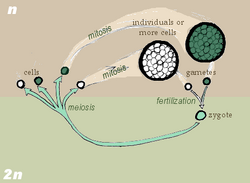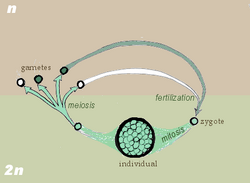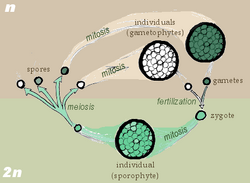Assessment |
Biopsychology |
Comparative |
Cognitive |
Developmental |
Language |
Individual differences |
Personality |
Philosophy |
Social |
Methods |
Statistics |
Clinical |
Educational |
Industrial |
Professional items |
World psychology |
Animals · Animal ethology · Comparative psychology · Animal models · Outline · Index
A life cycle is a period involving 1 generation of an organism through means of reproduction, whether through asexual reproduction or sexual reproduction. In regard to its ploidy, there are 3 types of cycles:
- haplontic life cycle
- diplontic life cycle
- diplobiontic life cycle (also referred to as diplohaplontic, haplodiplontic, or dibiontic life cycle)
These three types of cycles feature alternating haploid and all germinates. To return to a haploid stage, meiosis must occur (see Cell division). The cycles differ in the product of meiosis, and whether mitosis (growth) occurs. Zygotic and gametic meioses have one mitotic stage and form: during the n phase in zygotic meiosis and during the 2n phase in gametic meiosis. Therefore, zygotic and gametic meiosis are collectively term haplobiontic (single mitosis per phase). Sporic meiosis, on the other hand, has two mitosis events (diplobiontic): one in each phase.
Haplontic life cycle

Zygotic meiosis
A zygotic meiosis is a meiosis of a zygote immediately after karyogamy, which is the fusion of two cell nuclei. This way, the organism ends its diploid phase and produces several haploid cells. These cells divide mitotically to form either larger, multicellular individuals, or more haploid cells. Two opposite types of gametes (e.g., male and female) from these individuals or cells fuse to become a zygote.
In the whole cycle, zygotes are the only diploid cell; mitosis occurs only in the haploid phase.
The individuals or cells as a result of mitosis are haplonts, hence this life cycle is also called haplontic life cycle. Haplonts are:
- Most fungi
- Some green algae
- Many protozoa
Diplontic life cycle

Gametic meiosis
In gametic meiosis, instead of immediately dividing meiotically to produce haploid cells, the zygote divides mitotically to produce a multicellular diploid individual or a group of more unicellular diploid cells. Cells from the diploid individuals then undergo meiosis to produce haploid cells or gametes. Haploid cells may divide to form more haploid cells, as in many yeasts, but the haploid phase is not the predominant life cycle phase. In most diplonts, mitosis occurs only in the diploid phase, i.e. gametes usually form quickly and fuse to produce diploid zygotes.
In the whole cycle, gametes are usually the only haploid cells, and mitosis usually occurs only in the diploid phase.
The diploid multicellular individual is a diplont, hence a gametic meiosis is also called a diplontic life cycle. Diplonts are:
- Animals
- Some brown algae
- Some fungi, e.g. brewer's yeast
Haplodiplontic life cycle

Sporic meiosis
In sporic meiosis, the zygote divides mitotically to produce a multicellular diploid "sporophyte". The sporophyte creates spores via meiosis which also then divide mitotically producing haploid indivicuals called "gametophytes". Gametophytes now produce gametes via mitosis. In many plants the gametophyte is not only small-sized but also short-lived.
In the whole cycle, gametes are usually the only haploid cells, and mitosis usually occurs only in the diploid phase.
Haplodiplonts are:
- Most plants
- Some fungi
Life history
The term "Life history" is better than "life cycle" especially for the red algae (Rhodophyta). In the Rhodophyceae there are generally three stages and thus "alternation of generations" is not suitable.[1]
Life history theory
In animal and human biology life history theory is a method of understanding evolved behaviors and strategies to optimize reproductive success.
See also
- Aging
- Animal biological rhythms
- Animal sexual receptivity
- Biological rhythms
- Developmental stages
- Estrus
- Holometabolism
- Life changes
- Life expectancy
- Life span
- Life span development
- Menstruation
- Pregnancy
References
- ↑ Dixon, P.S. 1973. Biology of the Rhodophyta. Oliver & oyd, Edinburgh. ISBN 0 05 002485 X
| This page uses Creative Commons Licensed content from Wikipedia (view authors). |